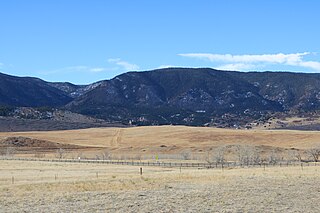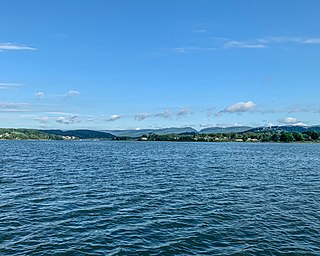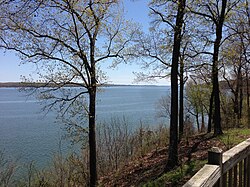
Grainger County is a county located in the U.S. state of Tennessee. As of the 2020 census, the population was 23,527. Its county seat is Rutledge. Grainger County is a part of the Knoxville Metropolitan Statistical Area and formerly Morristown Metropolitan Statistical Area until 2023.

Perry Park is an unincorporated community and a census-designated place (CDP) located in Douglas County, Colorado, United States. The CDP is a part of the Denver–Aurora–Lakewood, CO Metropolitan Statistical Area. The population of the Perry Park CDP was 1,932 at the United States Census 2020. The Perry Park Metropolitan District and the Perry Park Water & Sanitation District provide services. The Larkspur post office serves the area.

Tellico Dam is a concrete gravity and earthen embankment dam on the Little Tennessee River that was built by the Tennessee Valley Authority (TVA) in Loudon County, Tennessee. Planning for a dam structure on the Little Tennessee was reported as early as 1936 but was deferred for development until 1942. Completed in 1979, the dam created the Tellico Reservoir and is the last dam to be built by the Tennessee Valley Authority.

Joe Wheeler State Park is a public recreation area with resort features located on Wheeler Lake, an impoundment of the Tennessee River in northwest Alabama. The state park contains 2,550 acres (1,030 ha) of land in three separate parcels and adjoins the Tennessee Valley Authority's Wheeler Dam.

Lake Barkley, a 58,000-acre (230 km2) reservoir in Livingston County, Lyon County and Trigg County in Kentucky and extending into Stewart County and Houston County in Tennessee, was impounded by the U.S. Army Corps of Engineers in 1966 upon the completion of Barkley Dam. Both the lake and the dam are named for Vice President Alben Barkley, a Kentucky native.

Bean Station is a town split between the counties of Grainger and Hawkins in Tennessee, United States. As of the 2020 census, the population was 2,967. It is part of the Kingsport, Knoxville, and Morristown metropolitan statistical areas.
Buckhorn Lake, located south of Buckhorn, Kentucky, United States and northwest of Hazard, Kentucky off Kentucky Route 28, is a 1,230-acre (5 km2) reservoir created by the United States Army Corps of Engineers in 1967 by impounding the Middle Fork of the Kentucky River. The lake was flooded over top of a small township called Bowlingtown.

Kentucky Lake is a major navigable reservoir along the Tennessee River in Kentucky and Tennessee. It was created in 1944 by the Tennessee Valley Authority's impounding of the Tennessee River via Kentucky Dam for flood control and hydroelectric power. The 160,309-acre (649 km2) lake is the largest artificial lake by surface area in the United States east of the Mississippi River, with 2,064 miles (3,322 km) of shoreline. Kentucky Lake has a flood storage capacity of 4,008,000 acre⋅ft (4.944 km3), more than 2.5 times the next largest lake in the TVA system.

Kentucky Dam is a hydroelectric dam on the Tennessee River on the county line between Livingston and Marshall counties in the U.S. state of Kentucky. The dam is the lowermost of nine dams on the river owned and operated by the Tennessee Valley Authority, which built the dam in the late 1930s and early 1940s to improve navigation on the lower part of the river and reduce flooding on the lower Ohio and Mississippi rivers. It was a major project initiated during the New Deal of President Franklin D. Roosevelt's administration, to invest in infrastructure to benefit the country. The dam impounds the Kentucky Lake of 160,000 acres (65,000 ha), which is the largest of TVA's reservoirs and the largest artificial lake by area in the Eastern United States. It was designated as an National Historic Civil Engineering Landmark by the American Society of Civil Engineers in 1996 and listed on the National Register of Historic Places in 2017.

Jenny Wiley State Resort Park was founded as Dewey Lake State Park on January 1, 1954, with Dewey Lake near Prestonsburg, Kentucky as its centerpiece. It was renamed in the early 1950s for Virginia "Jenny" Wiley, a pioneer woman who is remembered as a survivor of captivity by Native Americans. It became one of the resort parks in the state in 1962 with the opening of the May Lodge.
Buckhorn Lake State Resort Park is a state park located in the northwest corner of Perry County, Kentucky. The park itself encompasses 856 acres (346 ha), while Buckhorn Lake, a mountain reservoir lake which serves as its major feature and which was created by damming the Middle Fork of the Kentucky River, covers approximately 1,230 acres (500 ha). The park is adjacent to the northern edge of the Daniel Boone National Forest.
Pennyrile Forest State Resort Park is a park located in northwestern Christian County, Kentucky, just south of Dawson Springs, Kentucky. The park encompasses 863 acres (349 ha) and takes its name from a colloquial form of the word pennyroyal, a small flowering plant native to the area.

Norris Dam State Park is a state park in Anderson County and Campbell County, Tennessee, in the southeastern United States. The park is situated along the shores of Norris Lake, an impoundment of the Clinch River created by the completion of Norris Dam in 1936. The park consists of 4,038 acres (16.34 km2) managed by the Tennessee Department of Environment and Conservation. The park also administers the Lenoir Museum Complex, which interprets the area's aboriginal, pioneer, and early 20th-century history.

Cherokee Lake, also known as Cherokee Reservoir, is an artificial reservoir in the U.S. state of Tennessee formed by the impoundment of the Holston River behind Cherokee Dam.

Cherokee State Park was a blacks-only state park located in Marshall County, Kentucky, near Hardin, Kentucky. It was a complement to the then-whites-only Kentucky Lake State Park, which was nearby. It was built by the Tennessee Valley Authority, which went along with the concept of the "separate but equal" doctrine. The TVA gave the state of Kentucky a nineteen-year lease, and promised to give Kentucky the area when it proved it could support the park. In its time it was dubbed "the finest colored vacation site in the South." This sentiment was echoed in a 1952 Kentucky state map.

Chatuge Dam is a flood control and hydroelectric dam on the Hiwassee River in Clay County, in the U.S. state of North Carolina. The dam is the uppermost of three dams on the river owned and operated by the Tennessee Valley Authority, which built the dam in the early 1940s for flood storage and to provide flow regulation at Hiwassee Dam further downstream. The dam impounds the 7,000-acre (2,800 ha) Chatuge Lake, which straddles the North Carolina-Georgia state line. While originally built solely for flood storage, a generator installed at Chatuge in the 1950s gives the dam a small hydroelectric output. At the time it was built, Chatuge Dam was the highest earthen dam in the world until the Aswan Dam was built in Egypt in 1964. The dam and associated infrastructure was listed on the National Register of Historic Places in 2017.
Perry Park is an unincorporated community, country club and golf resort in Owen County, Kentucky, near Owenton and Carrollton. It is located one hour southwest of Cincinnati, one hour northwest of Lexington, and forty-five minutes east of Louisville, and lies on the Kentucky River. The ZIP Code for Perry Park is 40363. Perry Park is located at coordinates 38°32′53″N84°59′59″W.

Land Between the Lakes National Recreation Area is a United States 171,280-acre national recreation area (69,310 ha) in Kentucky and Tennessee between Lake Barkley and Kentucky Lake. It was designated as a national recreation area in 1963 by President John F. Kennedy and developed using funds appropriated during the Johnson administration.
Cuba Lake is a 454-acre (1.84 km2) reservoir in Allegany and Cattaraugus counties, New York.

Poor Valley Creek State Park was a proposed state park in western Hawkins County, Tennessee, United States. It would have been located prominently near the Poor Valley Creek embayment of Cherokee Lake, an impoundment of the Holston River. The park was first planned in 1945, and shelved indefinitely following comments supporting "no action" on the project by state agencies in 1976.

















